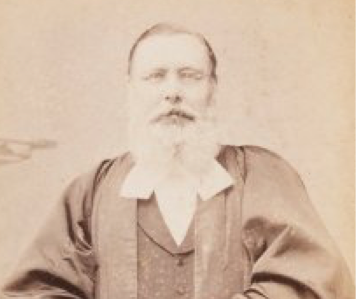Collingwood Notables Database
Nathaniel Kinsman
1823-1898
Lay preacher, marriage celebrant, auctioneer
Yorkshire-born Nathaniel Kinsman and his wife Lydia came to Victoria in 1849. After working as an assessor for Melbourne City Council, he set up his own business in Fitzroy. He was at first connected with St Mark’s Anglican Church in Fitzroy, and became associated with the new East Collingwood congregation, eventually known as St Philip’s. There he conducted lay services until he seceded to form the Victorian Free Church of England. He was to become known as ‘The Marrying Vicar’, reportedly officiating at more than 7000 marriages.
The business which Kinsman conducted from 1854 was in Moor Street Fitzroy, just off Smith Street. He was an auctioneer, land and house agent, and dealer in secondhand furniture. He was one of the trustees of St Mark’s in Fitzroy, which was close to his auction mart/home. At this time St Mark’s parish served Collingwood, but in February 1858 the Reverend James Linskea established services at the Anglican Christchurch School in Abbotsford, on the corner of Marine Parade and Nicholson Street. Linskea preached the opening sermon on 27 June 1858 and arranged for a continuation of services by Kinsman and other laymen. This was done until 1862 when the growing congregation justified the appointment of an ordained minister to take over services. Kinsman and some other members of the congregation objected to this, causing a schism. They formed the Victorian Free Church of England and by 1866 they had financed the construction of their own church building in Park Street Abbotsford, on the southeast corner of Studley Street. Kinsman rejected the authority of the bishops, but regarded his church as still part of the Church of England, adopting the liturgy of the Anglican Church with certain alterations. By 1871 the congregation exceeded 100 members, and a Sunday School was at some stage built on the opposite corner.
Kinsman was never ordained a minister of religion, but because he was the head of a denomination, he had the right to celebrate marriages. And this he did with a vengeance! As well as weddings for his little flock in the church, he performed many ceremonies in his home and developed quite a reputation. He was frequently written about in the press and reportedly officiated at over 7,000 marriage ceremonies.
According to one obituary:
The auctioneer walked out of his shop into his private parlor, and by the simple act of crossing the mat was transformed into the priest. The couples, mostly extremely young, and sometimes extremely old, seated themselves on the well-worn sofa … and the whole thing was over in a very few minutes.
The Weekly Times 5 March 1898, page 13
Marriages by ministers in their home were not unusual at the time, in fact regular advertisements to this effect can be found in contemporary newspapers. The cost might be 10/6, or £1.1.0 if the officiating clergyman supplied a gold ring and witnesses. Such weddings were cheap, and also quickly arranged, because, unlike a wedding in a church, there was no requirement for notice to be given. Kinsman was suspected of not being very careful in his inquiries as to the legitimacy of the bride and groom’s statements. Given the massive volume of services (even if the actual number was exaggerated) it is hardly surprising that Kinsman was occasionally in court in relation to illegal marriages, such as bigamy, or marrying a minor without a parent’s consent. He often came in for criticism, but vigorously defended himself. Even after his death the denigration continued.
The ''Rev.'' Nathaniel Kinsman, who has for many years been well known in Melbourne as the ''marrying parson'' died on 24th ult. With Mr Kinsman the celebration of marriage was purely a matter of business; the charges were regulated to ''suit the times'' and the pockets of the parties, and all possible facilities were offered…. Some of them, no doubt, proved to be happy unions, but a very large proportion of them, it is absolutely certain, turned out quite contrariwise. The records of the Divorce Court prove this indisputably. Only last week Mr. Justice a'Beckett publicly objected to hearing him styled as "Reverend".
Melbourne Leader, 5 March 1898, page 5
Despite his regular income, Kinsman did not die a wealthy man, leaving his widow with the property in Moor Street and a little over one hundred pounds. He was reputed to have been very charitable, regularly giving away large sums. His funeral service was held at the church in Park Street, but it seems that with his demise the congregational momentum must have diminished. By the middle of the first decade of the twentieth century there was no sign of ongoing occupation, and both the church and the Sunday School have long since been demolished.
Life Summary
| Birth Date | Birth Place |
|---|---|
| 1823 | West Yorkshire |
| Spouse Name | Date of Marriage | Children |
|---|---|---|
| Lydia Leeming, c. 1825-1905 | 1845 | None |
| Home Street | Home City | Status of Building |
|---|---|---|
| 224 Moor Street | Fitzroy | Extant |
| Work Street | Work City | Status of Building |
|---|---|---|
| Park Street, se corner StudleyStreet | Abbotsford | Demolished |
| Church | Lodge |
|---|---|
| St Philip's Anglican, Abbotsford | |
| Free Church of England, Abbotsford |
| Death Date | Death Place | Cemetery |
|---|---|---|
| 24 February 1898 | Fitzroy | MGC |
Barrett, The inner suburbs; Historical Notes on the Church and Parish of St Mark the Evangelist Fitzroy. By an Old Parishioner (ie C Baker); Peterson, Brimstone to Bunyip; Cummings, Bitter roots, sweet fruit; The Weekly Times; Melbourne Leader; The Argus; The Age; Port Philip Gazette; The Banner; Mercury and Weekly Courier; Geelong Advertiser; The Australian Star; Bendigo Advertiser; Melbourne Punch; Truth.

